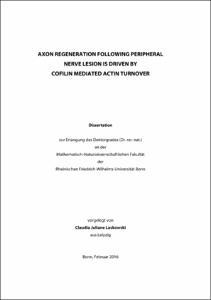Laskowski, Claudia Juliane: Axon regeneration following peripheral nerve lesion is driven by cofilin mediated actin turnover. - Bonn, 2016. - Dissertation, Rheinische Friedrich-Wilhelms-Universität Bonn.
Online-Ausgabe in bonndoc: https://nbn-resolving.org/urn:nbn:de:hbz:5n-44193
Online-Ausgabe in bonndoc: https://nbn-resolving.org/urn:nbn:de:hbz:5n-44193
@phdthesis{handle:20.500.11811/6844,
urn: https://nbn-resolving.org/urn:nbn:de:hbz:5n-44193,
author = {{Claudia Juliane Laskowski}},
title = {Axon regeneration following peripheral nerve lesion is driven by cofilin mediated actin turnover},
school = {Rheinische Friedrich-Wilhelms-Universität Bonn},
year = 2016,
month = sep,
note = {While axons of the adult peripheral nervous system (PNS) maintain the ability to regenerate, axons of the central nervous system (CNS) fail to regrow upon injury. Subsequently, trauma to the spinal cord leads to irreversible loss of function below the site of injury. Primary sensory neurons constitute a classical exception. A lesion to the peripheral axons of dorsal root ganglia (DRG) neurons is able to reinitiate the intrinsic competence for axonal growth and to trigger regeneration in their central axons. This phenomenon called "conditioning" demonstrated decades ago that axon regeneration is possible in the CNS. However, the understanding of the underlying mechanisms is still fragmentary. My data show direct correlations between changes of the actin and microtubule cytoskeleton and the observed increase in axonal growth following a conditioning lesion. The morphology and the mode of elongation of DRG growth cones are significantly altered. Most importantly, I report that high actin dynamics and turnover are necessary for axon regeneration. My data indicate that a single family of actin regulatory proteins, actin depolymerizing protein (ADF)/cofilin (AC), drives the conditioning regenerative response. In fact, genetic ablation of all 3 isoforms of the AC family, ADF, cofilin 1 and cofilin 2 leads to a complete loss of the conditioning effect both in cell culture and in vivo. Blockade of F-actin retrograde flow and protrusion dynamics accounted for this failure in axon growth and regeneration. In particular, I found that the actin severing activity of AC proteins is essential for axon growth and regeneration. To assess whether AC activity is not only necessary but also sufficient for axon growth, AC isoforms were overexpressed individually in DRG neurons. In vitro, overexpression of cofilin 1, but not ADF and cofilin 2 enhanced axon outgrowth on both permissive and inhibitory substrates. In conclusion, my data reveal that actin remodeling contributes to mediating the conditioning effect in adult DRG neurons. Moreover, AC mediated actin turnover facilitates axon growth and regeneration by recapitulating processes that occur during neurite initiation in development.},
url = {https://hdl.handle.net/20.500.11811/6844}
}
urn: https://nbn-resolving.org/urn:nbn:de:hbz:5n-44193,
author = {{Claudia Juliane Laskowski}},
title = {Axon regeneration following peripheral nerve lesion is driven by cofilin mediated actin turnover},
school = {Rheinische Friedrich-Wilhelms-Universität Bonn},
year = 2016,
month = sep,
note = {While axons of the adult peripheral nervous system (PNS) maintain the ability to regenerate, axons of the central nervous system (CNS) fail to regrow upon injury. Subsequently, trauma to the spinal cord leads to irreversible loss of function below the site of injury. Primary sensory neurons constitute a classical exception. A lesion to the peripheral axons of dorsal root ganglia (DRG) neurons is able to reinitiate the intrinsic competence for axonal growth and to trigger regeneration in their central axons. This phenomenon called "conditioning" demonstrated decades ago that axon regeneration is possible in the CNS. However, the understanding of the underlying mechanisms is still fragmentary. My data show direct correlations between changes of the actin and microtubule cytoskeleton and the observed increase in axonal growth following a conditioning lesion. The morphology and the mode of elongation of DRG growth cones are significantly altered. Most importantly, I report that high actin dynamics and turnover are necessary for axon regeneration. My data indicate that a single family of actin regulatory proteins, actin depolymerizing protein (ADF)/cofilin (AC), drives the conditioning regenerative response. In fact, genetic ablation of all 3 isoforms of the AC family, ADF, cofilin 1 and cofilin 2 leads to a complete loss of the conditioning effect both in cell culture and in vivo. Blockade of F-actin retrograde flow and protrusion dynamics accounted for this failure in axon growth and regeneration. In particular, I found that the actin severing activity of AC proteins is essential for axon growth and regeneration. To assess whether AC activity is not only necessary but also sufficient for axon growth, AC isoforms were overexpressed individually in DRG neurons. In vitro, overexpression of cofilin 1, but not ADF and cofilin 2 enhanced axon outgrowth on both permissive and inhibitory substrates. In conclusion, my data reveal that actin remodeling contributes to mediating the conditioning effect in adult DRG neurons. Moreover, AC mediated actin turnover facilitates axon growth and regeneration by recapitulating processes that occur during neurite initiation in development.},
url = {https://hdl.handle.net/20.500.11811/6844}
}






